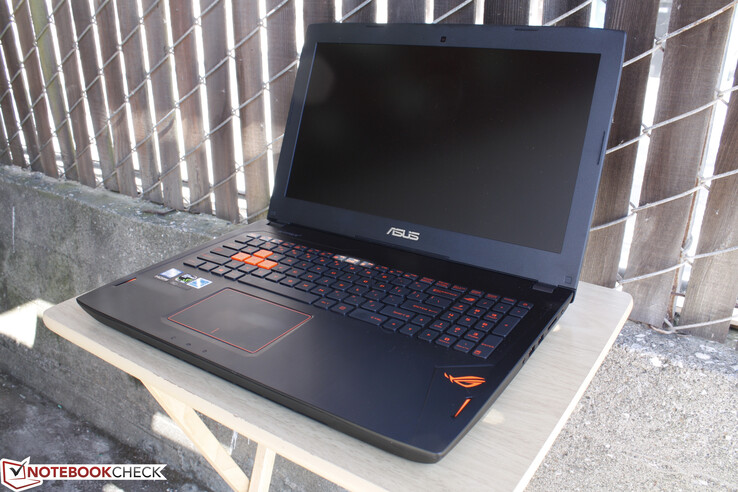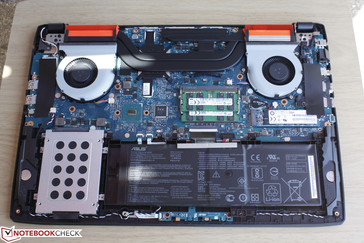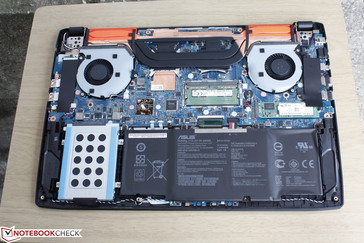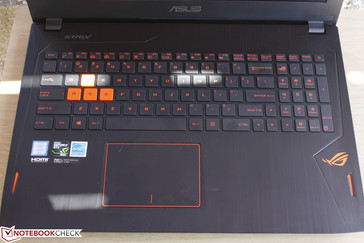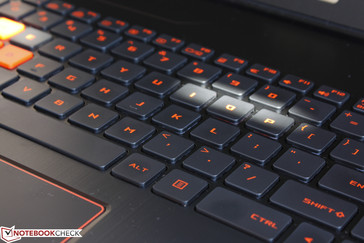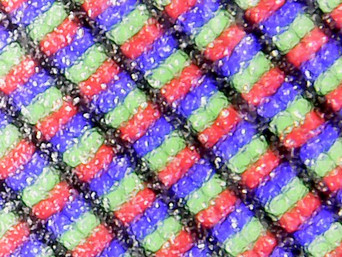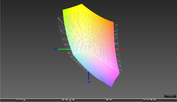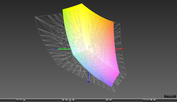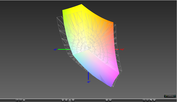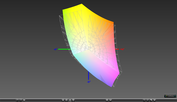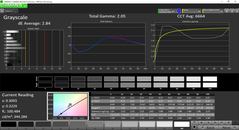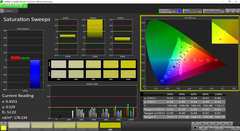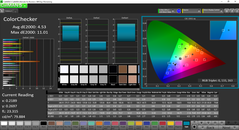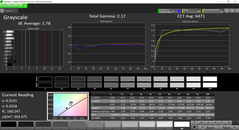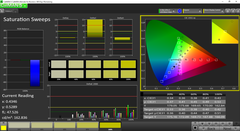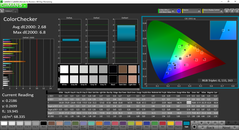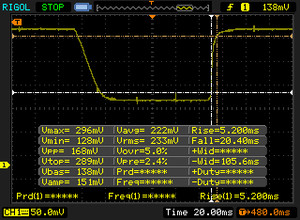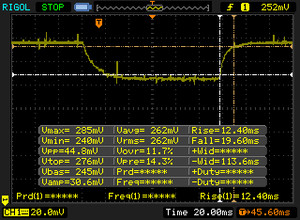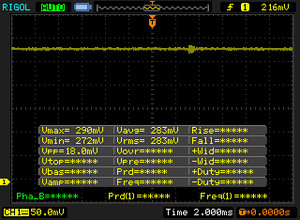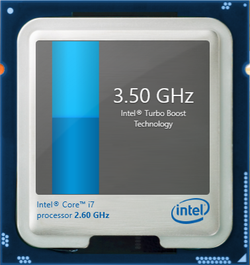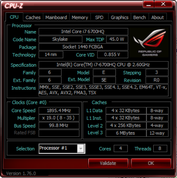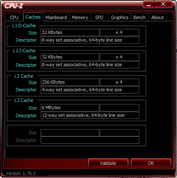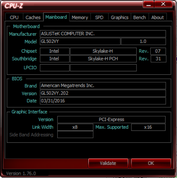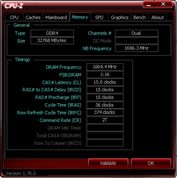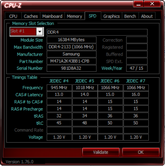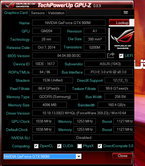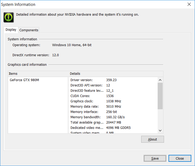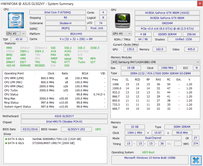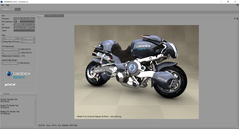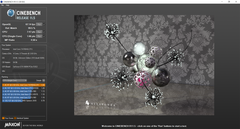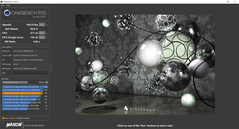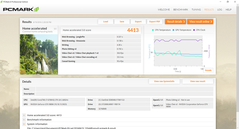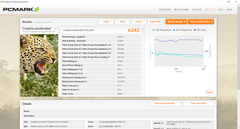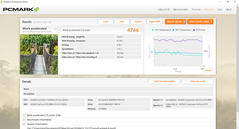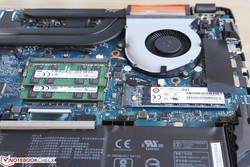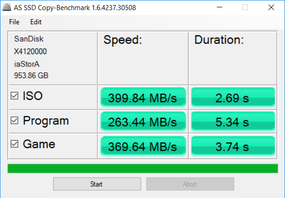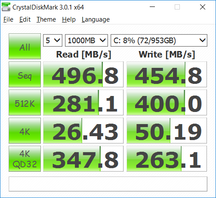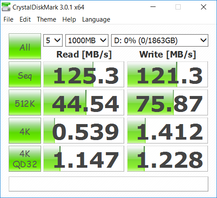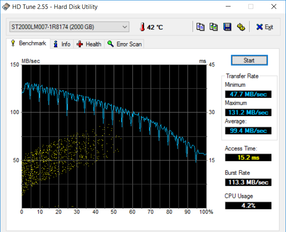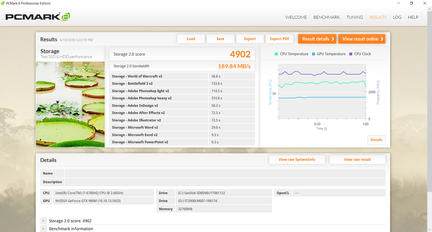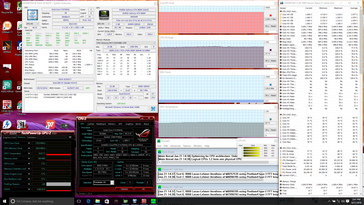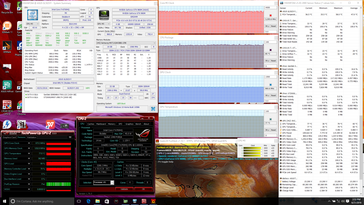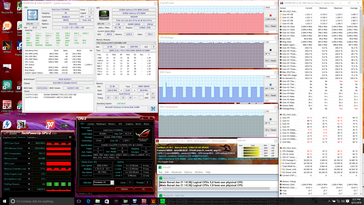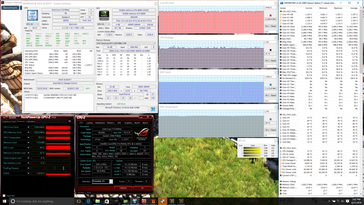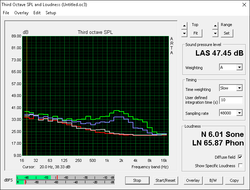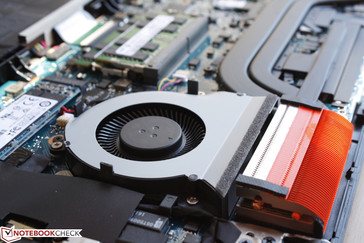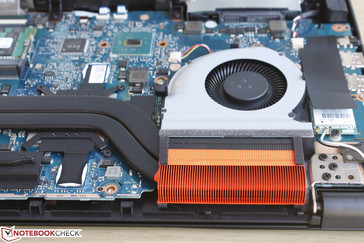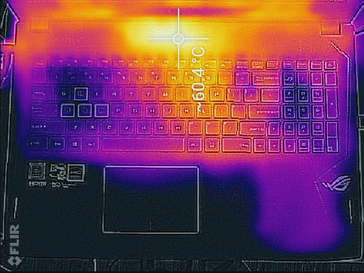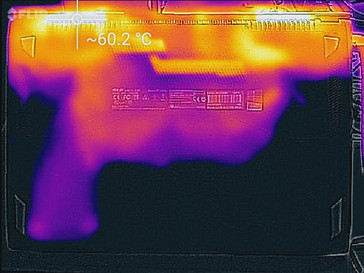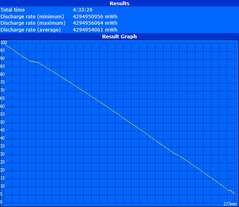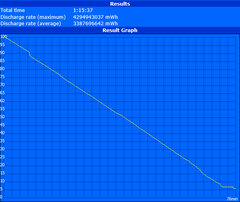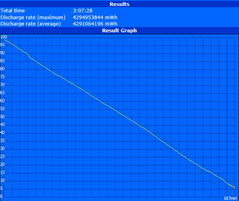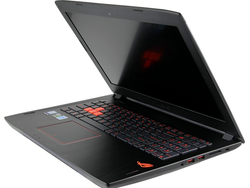Asus ROG Strix GL502VY-DS71 Notebook Review

Our overview on the GL502VT from earlier this month shows that Asus may have a winner on its hands as an alternative to the larger and more popular G752 series. Whereas the current 15.6-inch GL552, G501, and UX501 series are generally solid, none of them are able to carry the almighty GTX 980M GPU whereas the GL502 series at least has the option. This instantly pits the GL502 against flagship competitors like the Aorus X5S v5 and the thicker Acer Predator 15 and Alienware 15 R2.
Our page today focuses on the GL502VY and its GTX 980M and how this compares to our last GL502VT SKU and its GTX 970M GPU. While the Core i7-6700HQ CPU remains identical, there are indeed differences between them in terms of the display, RAM, and cooling solution. What steps has the manufacturer taken to make sure that the system can run reliably on a more demanding GPU?
The GL502VY currently retails for $1700 USD while the GL502VT can be found for as low as $1100 USD. Our test model was provided by reseller CUKUSA, so storage and RAM options here may not be exactly identical to a direct SKU from Asus. See our previous review on the GL502VT for more images and details on chassis quality, input devices, and connectivity options.
Case
The chassis is identical to the GL502VT and we can find no manufacturing defects or unintended gaps on our GL502VY test unit. As mentioned in our previous review, the bright traffic cone Orange may not resonate with all users compared to the deeper red, silver, and/or black colors of other ROG notebooks, but the quality of the chassis is superb and stronger than on the Aorus X5S. Nonetheless, it's not quite as rigid as the Alienware 15 or Asus G752 as these latter notebooks are much heavier, thicker, and with more limited serviceability options.
Connectivity
No changes have been made to its connectivity options. All ports are located towards the back edges of the notebook with none on the rear, so all are easy to reach for both left- and right-handed users. The lack of Thunderbolt 3 may irk some enthusiasts.
Communication
WLAN is provided by a 2x2 Killer 1535 M.2 module with more features designed around signal maximization (beamforming) and efficiency (MU-MIMO). Otherwise, its theoretical throughout is identical to the Intel 8260 at 867 Mbps via an 802.11ac network. More features of the Killer 1535 card can be found on its product page.
Maintenance
Serviceability is easy on the GL502 series and CUKUSA even offers a detailed disassembly guide for all users. As expected, the cooling system on the GL502VY is largely identical to the GL502VT. The heat pipes here do appears slightly thicker, however, and the heat sinks are designed a bit differently as well. Users will also notice that the GL502VY includes 2x SODIMM slots and no soldered RAM unlike on the GL502VT.
Warranty
The standard one-year manufacturer warranty applies with a 30-day protection against any number of stuck pixels. CUKUSA also offers three-year warranty as standard for any aftermarket or modified hardware installed by the reseller. This can include the HDD, SSD, WLAN, and RAM modules depending on the configuration.
Input Devices
The keyboard should feel instantly familiar to anyone who has used an Asus G752, UX501, or GL552 as the manufacturer employs a similar Chiclet layout across most of its gaming notebooks. The touchpad here is slightly different, however, as it is not as recessed as on the UX501 or GL552 and is thus easier to press. Precision will always be a step below systems with dedicated mouse keys like the G752.
Auxiliary keys and/or dedicated Macro keys would have made the system more attractive to core gamers.
Display
Subjectively, the 1080p matte displays between the GL502VY and GL502VT appear similar with excellent clarity and minimal graininess. Look a bit deeper into the specifications, however, and the differences begin to show. This particular SKU is equipped with G-Sync and uses a LG Philips LP156W6 (LGD046F) panel compared to the Samsung SDC324C panel in our GL502VT. As a result, some differences in average brightness, color accuracy, and gamut can be measured. In particular, the GL502VY carries a slightly brighter display while keeping contrast about the same. Note that this particular panel from LG Philips is also used in number of other gaming notebooks including the Eurocom Shark 4, Acer Predator 15, Alienware 15 R2, and even the HP Spectre x360 convertible.
On the flip side, uneven backlight bleeding is more noticeable on our test unit compared to our GL502VT. We can see moderate light leaks from the top corners and bottom edges when viewing movies in letterbox. It's not severe enough to be a distraction, but we expected more from this price range.
| |||||||||||||||||||||||||
Brightness Distribution: 88 %
Center on Battery: 347.2 cd/m²
Contrast: 998:1 (Black: 0.348 cd/m²)
ΔE ColorChecker Calman: 4.53 | ∀{0.5-29.43 Ø4.78}
ΔE Greyscale Calman: 2.84 | ∀{0.09-98 Ø5}
84.1% sRGB (Argyll 1.6.3 3D)
54.7% AdobeRGB 1998 (Argyll 1.6.3 3D)
61.6% AdobeRGB 1998 (Argyll 3D)
84.3% sRGB (Argyll 3D)
63% Display P3 (Argyll 3D)
Gamma: 2.05
CCT: 6664 K
| Asus Strix GL502VY-DS71 15.6", 1920x1080 | Asus Strix GL502VT-DS74 15.6", 1920x1080 | Aorus X5S v5 15.6", 3840x2160 | Alienware 15 R2 (Skylake) 15.6", 1920x1080 | Asus G501VW-FY081T 15.6", 1920x1080 | |
|---|---|---|---|---|---|
| Display | 11% | 6% | -32% | 11% | |
| Display P3 Coverage (%) | 63 | 66.7 6% | 63.5 1% | 40.3 -36% | 66.8 6% |
| sRGB Coverage (%) | 84.3 | 97.7 16% | 92.7 10% | 60.2 -29% | 97.3 15% |
| AdobeRGB 1998 Coverage (%) | 61.6 | 68.4 11% | 65 6% | 41.67 -32% | 68.6 11% |
| Response Times | -70% | -35% | -31% | -54% | |
| Response Time Grey 50% / Grey 80% * (ms) | 32 ? | 56.4 ? -76% | 41.2 ? -29% | 48.8 ? -53% | 50 ? -56% |
| Response Time Black / White * (ms) | 25.6 ? | 41.6 ? -63% | 36 ? -41% | 28 ? -9% | 39 ? -52% |
| PWM Frequency (Hz) | 201.6 ? | 198 ? | 200 ? | 200 ? | |
| Screen | -17% | 9% | -33% | 0% | |
| Brightness middle (cd/m²) | 347.2 | 296.8 -15% | 324.7 -6% | 180 -48% | 341 -2% |
| Brightness (cd/m²) | 327 | 282 -14% | 324 -1% | 179 -45% | 312 -5% |
| Brightness Distribution (%) | 88 | 86 -2% | 90 2% | 83 -6% | 83 -6% |
| Black Level * (cd/m²) | 0.348 | 0.347 -0% | 0.403 -16% | 0.19 45% | 0.32 8% |
| Contrast (:1) | 998 | 855 -14% | 806 -19% | 947 -5% | 1066 7% |
| Colorchecker dE 2000 * | 4.53 | 5.24 -16% | 2.62 42% | 6.74 -49% | 4.23 7% |
| Colorchecker dE 2000 max. * | 11.01 | 11.36 -3% | 4.59 58% | 8.02 27% | |
| Greyscale dE 2000 * | 2.84 | 6.76 -138% | 2.55 10% | 6.44 -127% | 4.69 -65% |
| Gamma | 2.05 107% | 2.24 98% | 2.11 104% | 2.29 96% | 2.53 87% |
| CCT | 6664 98% | 8467 77% | 7000 93% | 6465 101% | 7549 86% |
| Color Space (Percent of AdobeRGB 1998) (%) | 54.7 | 62.8 15% | 59.4 9% | 38 -31% | 63 15% |
| Color Space (Percent of sRGB) (%) | 84.1 | 98.1 17% | 92.3 10% | 60 -29% | 97 15% |
| Total Average (Program / Settings) | -25% /
-18% | -7% /
2% | -32% /
-32% | -14% /
-5% |
* ... smaller is better
Color coverage is approximately 55 percent and 84 percent of AdobeRGB and sRGB, respectively. In comparison, the Samsung panel in our GL502VT covers nearly 100 percent of sRGB and 63 percent of AdobeRGB. Even so, the GL502VY offers deeper colors than a handful of other 15-inch gaming notebooks including the Alienware 15 R2. Wider color spaces and more accurate colors are generally unimportant for gaming purposes compared to aspects like contrast ratio and ghosting.
Further analyses with an X-Rite spectrophotometer reveal colors that are about as accurate as the GL502VT out-of-the-box. However, since the gamut on the GL502VY display is slightly narrower, the system benefits less from calibration. Our measurements after a quick calibration prove this to be true as colors are still slightly inferior to the GL502VT. For example, color accuracy improves across all tested saturation levels, but they still become less accurate the deeper the saturation due to the panel's smaller sRGB coverage.
Display Response Times
| ↔ Response Time Black to White | ||
|---|---|---|
| 25.6 ms ... rise ↗ and fall ↘ combined | ↗ 5.2 ms rise | |
| ↘ 20.4 ms fall | ||
| The screen shows relatively slow response rates in our tests and may be too slow for gamers. In comparison, all tested devices range from 0.1 (minimum) to 240 (maximum) ms. » 60 % of all devices are better. This means that the measured response time is worse than the average of all tested devices (20.2 ms). | ||
| ↔ Response Time 50% Grey to 80% Grey | ||
| 32 ms ... rise ↗ and fall ↘ combined | ↗ 12.4 ms rise | |
| ↘ 19.6 ms fall | ||
| The screen shows slow response rates in our tests and will be unsatisfactory for gamers. In comparison, all tested devices range from 0.165 (minimum) to 636 (maximum) ms. » 42 % of all devices are better. This means that the measured response time is similar to the average of all tested devices (31.6 ms). | ||
Screen Flickering / PWM (Pulse-Width Modulation)
| Screen flickering / PWM not detected | |||
In comparison: 53 % of all tested devices do not use PWM to dim the display. If PWM was detected, an average of 8108 (minimum: 5 - maximum: 343500) Hz was measured. | |||
Outdoor visibility is above average under shade due to the bright backlight and matte panel to reduce glare and reflections. Direct sunlight still proves to be too much for the display, so colors and texts will become washed out and uncomfortable to read for long periods. Viewing angles are otherwise excellent as expected from an IPS panel. Colors and contrast do not degrade unless if viewing from abnormally obtuse angles.
Performance
Main hardware differences between the GL502VY and the GL502VT are the GPU (GTX 980M vs. GTX 970M), display (G-Sync vs. no G-Sync), WLAN (Killer 1535 vs. Intel 8260), RAM (2x SODIMM vs. 1x SODIMM), and slight variations to the cooling system. The RAM differences in particular are notable as this means that the GL502VY can be upgraded to 32 GB RAM vs. 24 GB on the GL502VT (8 GB soldered + 16 GB DDR4 SODIMM).
Hardcore gamers will notice that the only available GTX 980M option here includes just 4 GB GDDR5 VRAM compared to 8 GB GDDR5 VRAM on larger and pricier gaming systems.
Processor
The Core i7-6700HQ is probably the most common Skylake CPU option for gaming notebooks. Thus, its performance has been well documented in our database. Raw processor performance is not a huge upgrade over the previous generation Broadwell i7-5700HQ or even the Haswell i7-4700HQ while the desktop-class i7-6700K is roughly 15 percent and 30 percent faster in single-threaded and multi-threaded applications, respectively. No throttling occurred during our CineBench tests.
See our dedicated CPU page on the Core i7-6700HQ for more technical information and benchmark comparisons.
| Cinebench R15 | |
| CPU Single 64Bit (sort by value) | |
| Asus Strix GL502VY-DS71 | |
| DogHouse Systems Mobius SS | |
| Gigabyte P55 V4 | |
| EVGA SC17 | |
| Asus Strix GL502VT-DS74 | |
| MSI GE70-2PC-036XPL | |
| CPU Multi 64Bit (sort by value) | |
| Asus Strix GL502VY-DS71 | |
| DogHouse Systems Mobius SS | |
| Gigabyte P55 V4 | |
| EVGA SC17 | |
| Asus Strix GL502VT-DS74 | |
| MSI GE70-2PC-036XPL | |
| Cinebench R11.5 | |
| CPU Single 64Bit (sort by value) | |
| Asus Strix GL502VY-DS71 | |
| DogHouse Systems Mobius SS | |
| Gigabyte P55 V4 | |
| EVGA SC17 | |
| Asus Strix GL502VT-DS74 | |
| MSI GE70-2PC-036XPL | |
| CPU Multi 64Bit (sort by value) | |
| Asus Strix GL502VY-DS71 | |
| DogHouse Systems Mobius SS | |
| Gigabyte P55 V4 | |
| EVGA SC17 | |
| Asus Strix GL502VT-DS74 | |
| MSI GE70-2PC-036XPL | |
| Cinebench R10 | |
| Rendering Multiple CPUs 32Bit (sort by value) | |
| Asus Strix GL502VY-DS71 | |
| DogHouse Systems Mobius SS | |
| Gigabyte P55 V4 | |
| EVGA SC17 | |
| Asus Strix GL502VT-DS74 | |
| MSI GE70-2PC-036XPL | |
| Rendering Single 32Bit (sort by value) | |
| Asus Strix GL502VY-DS71 | |
| DogHouse Systems Mobius SS | |
| Gigabyte P55 V4 | |
| EVGA SC17 | |
| Asus Strix GL502VT-DS74 | |
| MSI GE70-2PC-036XPL | |
| wPrime 2.10 - 1024m (sort by value) | |
| Asus Strix GL502VY-DS71 | |
| DogHouse Systems Mobius SS | |
| Gigabyte P55 V4 | |
| EVGA SC17 | |
| Asus Strix GL502VT-DS74 | |
| MSI GE70-2PC-036XPL | |
| Super Pi Mod 1.5 XS 32M - 32M (sort by value) | |
| Asus Strix GL502VY-DS71 | |
| DogHouse Systems Mobius SS | |
| Gigabyte P55 V4 | |
| EVGA SC17 | |
| Asus Strix GL502VT-DS74 | |
| MSI GE70-2PC-036XPL | |
* ... smaller is better
System Performance
PCMark 8 ranks our system in the same ballpark as many of its competitors and sometimes even higher depending on the individual test. We experienced no software or hardware issues specific to our test unit during our review.
| PCMark 8 | |
| Home Score Accelerated v2 (sort by value) | |
| Asus Strix GL502VY-DS71 | |
| Alienware 15 R2 (Skylake) | |
| Asus Strix GL502VT-DS74 | |
| Asus G501VW-FY081T | |
| Aorus X5S v5 | |
| Work Score Accelerated v2 (sort by value) | |
| Asus Strix GL502VY-DS71 | |
| Alienware 15 R2 (Skylake) | |
| Asus Strix GL502VT-DS74 | |
| Asus G501VW-FY081T | |
| Aorus X5S v5 | |
| Creative Score Accelerated v2 (sort by value) | |
| Asus Strix GL502VY-DS71 | |
| Alienware 15 R2 (Skylake) | |
| Asus Strix GL502VT-DS74 | |
| Asus G501VW-FY081T | |
| Aorus X5S v5 | |
| PCMark 8 Home Score Accelerated v2 | 4413 points | |
| PCMark 8 Creative Score Accelerated v2 | 6343 points | |
| PCMark 8 Work Score Accelerated v2 | 4766 points | |
Help | ||
Storage Devices
Like our GL502VT configuration, our GL502VY SKU includes a SATA III M.2 SSD and a secondary HDD. The exact models are different, of course, as our reseller has equipped a 1 TB SanDisk SD8SN8U1T001122 M.2 SSD and a secondary 2 TB Seagate ST2000LM007 HDD. This particular SanDisk SSD was also featured on our Gigabyte P55K v5 and overall performance according to AS SSD is similar between them. Gaming systems with NVMe SSDs can perform up to 3x or 4x faster especially in sequential read rate. The Asus notebook supports NVMe despite the fact that our test unit did not come with a NVMe-enabled SSD.
See our growing table of SSDs and HDDs for more benchmark comparisons.
| Asus Strix GL502VY-DS71 GeForce GTX 980M, 6700HQ, SanDisk SD8SN8U1T001122 | Asus Strix GL502VT-DS74 GeForce GTX 970M, 6700HQ, Lite-On CV1-8B128 | Aorus X5S v5 GeForce GTX 980M, 6700HQ, Samsung SM951 MZVPV256 m.2 | Gigabyte P55K v5 GeForce GTX 965M, 6700HQ, SanDisk SD8SN8U1T001122 | Asus G501VW-FY081T GeForce GTX 960M, 6700HQ, Samsung CM871 MZNLF128HCHP | |
|---|---|---|---|---|---|
| AS SSD | -3% | 143% | -2% | -70% | |
| Copy Game MB/s (MB/s) | 369.6 | 377.7 2% | 688 86% | 377.5 2% | 141.5 -62% |
| Copy Program MB/s (MB/s) | 263.4 | 178.8 -32% | 357.9 36% | 178.2 -32% | 99.9 -62% |
| Copy ISO MB/s (MB/s) | 399.8 | 342 -14% | 1319 230% | 354.5 -11% | 163 -59% |
| Score Total (Points) | 879 | 790 -10% | 2433 177% | 868 -1% | 269 -69% |
| Score Write (Points) | 308 | 249 -19% | 509 65% | 311 1% | 63 -80% |
| Score Read (Points) | 380 | 363 -4% | 1298 242% | 366 -4% | 152 -60% |
| Access Time Write * (ms) | 0.088 | 0.052 41% | 0.032 64% | 0.085 3% | 0.225 -156% |
| Access Time Read * (ms) | 0.086 | 0.086 -0% | 0.049 43% | 0.087 -1% | 0.207 -141% |
| 4K-64 Write (MB/s) | 235.1 | 164 -30% | 290.8 24% | 227.9 -3% | 19.4 -92% |
| 4K-64 Read (MB/s) | 304.6 | 283.1 -7% | 1059 248% | 294.6 -3% | 87.6 -71% |
| 4K Write (MB/s) | 42.43 | 67.6 59% | 115.9 173% | 46.73 10% | 30.66 -28% |
| 4K Read (MB/s) | 24.36 | 28.06 15% | 45.81 88% | 25.09 3% | 13.87 -43% |
| Seq Write (MB/s) | 300.1 | 174 -42% | 1019 240% | 360.4 20% | 126.9 -58% |
| Seq Read (MB/s) | 506 | 516 2% | 1925 280% | 467.6 -8% | 504 0% |
* ... smaller is better
GPU Performance
3DMark benchmarks show the GTX 980M in the Asus to be just as fast as the GTX 980M in the much larger and pricier DogHouse Systems Mobius SS. Thus, performance and clock rates aren't artificially throttled in any way. Moving from the GTX 970M to the GTX 980M will lead to a raw performance boost of about 30 percent while moving from the GTX 980M to the GTX 980 Notebook will lead to yet another 30 percent gain according to Fire Strike benchmarks.
| 3DMark 11 | |
| 1280x720 Performance GPU (sort by value) | |
| Asus Strix GL502VY-DS71 | |
| Eurocom Sky DLX7 | |
| DogHouse Systems Mobius SS | |
| Asus Strix GL502VT-DS74 | |
| MSI GL62-6QFi781H11 | |
| 1280x720 Performance Combined (sort by value) | |
| Asus Strix GL502VY-DS71 | |
| Eurocom Sky DLX7 | |
| DogHouse Systems Mobius SS | |
| Asus Strix GL502VT-DS74 | |
| MSI GL62-6QFi781H11 | |
| 3DMark | |
| 1920x1080 Fire Strike Graphics (sort by value) | |
| Asus Strix GL502VY-DS71 | |
| Eurocom Sky DLX7 | |
| DogHouse Systems Mobius SS | |
| Asus Strix GL502VT-DS74 | |
| MSI GL62-6QFi781H11 | |
| Fire Strike Extreme Graphics (sort by value) | |
| Asus Strix GL502VY-DS71 | |
| Eurocom Sky DLX7 | |
| DogHouse Systems Mobius SS | |
| Asus Strix GL502VT-DS74 | |
| 3840x2160 Fire Strike Ultra Graphics (sort by value) | |
| Asus Strix GL502VY-DS71 | |
| Eurocom Sky DLX7 | |
| DogHouse Systems Mobius SS | |
| 3DMark 11 Performance | 11177 points | |
| 3DMark Ice Storm Standard Score | 103899 points | |
| 3DMark Cloud Gate Standard Score | 23034 points | |
| 3DMark Fire Strike Score | 8282 points | |
| 3DMark Fire Strike Extreme Score | 4407 points | |
Help | ||
Gaming Performance
The GTX 980M is capable of playing today's titles on High settings at 1080p60. Note, however, that its 4 GB VRAM will become more of a bottleneck in the following years and especially if users decide to game on higher resolutions through an external monitor. The Aorus X5S, for example, outperforms the Asus by a few frames more in newer games and the gap is expected continue for future demanding titles.
See our dedicated GPU page on the GTX 980M for more technical information and benchmark comparisons.
| Thief - 1920x1080 Very High Preset AA:FXAA & High SS AF:8x | |
| Eurocom Sky DLX7 | |
| Aorus X5S v5 | |
| Asus Strix GL502VY-DS71 | |
| Asus Strix GL502VT-DS74 | |
| MSI PE60 6QE-056XUS | |
| BioShock Infinite - 1920x1080 Ultra Preset, DX11 (DDOF) | |
| Eurocom Sky DLX7 | |
| Aorus X5S v5 | |
| Asus Strix GL502VY-DS71 | |
| Asus Strix GL502VT-DS74 | |
| MSI PE60 6QE-056XUS | |
| Sleeping Dogs - 1920x1080 Extreme Preset AA:Extreme | |
| Eurocom Sky DLX7 | |
| Aorus X5S v5 | |
| Asus Strix GL502VY-DS71 | |
| Asus Strix GL502VT-DS74 | |
| Metal Gear Solid V - 1920x1080 Extra High / On | |
| Eurocom Sky DLX7 | |
| Aorus X5S v5 | |
| Asus Strix GL502VT-DS74 | |
| Asus Strix GL502VY-DS71 | |
| MSI PE60 6QE-056XUS | |
| Fallout 4 - 1920x1080 Ultra Preset AA:T AF:16x | |
| Asus Strix GL502VY-DS71 | |
| Aorus X5S v5 | |
| Asus Strix GL502VT-DS74 | |
| MSI PE60 6QE-056XUS | |
| Rise of the Tomb Raider - 1920x1080 Very High Preset AA:FX AF:16x | |
| Asus Strix GL502VY-DS71 | |
| Aorus X5S v5 | |
| Asus Strix GL502VT-DS74 | |
| MSI PE60 6QE-056XUS | |
| low | med. | high | ultra | |
|---|---|---|---|---|
| Sleeping Dogs (2012) | 137.8 | 57.5 | ||
| BioShock Infinite (2013) | 166 | 86.4 | ||
| Thief (2014) | 94.6 | 58.6 | ||
| Batman: Arkham Knight (2015) | 73 | |||
| Metal Gear Solid V (2015) | 60 | 60 | ||
| Fallout 4 (2015) | 72.6 | 57.9 | ||
| Rise of the Tomb Raider (2016) | 59.6 | 55 | ||
| Doom (2016) | 57 | 56 | ||
| Overwatch (2016) | 138.4 | 87.3 |
Stress Test
We stress the notebook with synthetic benchmarks to identify for any throttling or stability issues. Core temperatures are not wildly different than the GL502VT despite our previous SKU running a GTX 970M. GPU temperature is just a few degrees warmer under Unigine Heaven stress while the CPU is slightly cooler in the low 70 C range. Otherwise, users will be glad to know that no throttling should occur when gaming as the GPU will run at a constant 1114 MHz clock rate. The CPU in particular is very good at maintaining its Turbo Boost speeds even when under extreme stress.
Running on battery power will throttle GPU performance while the CPU remains unaffected. A 3DMark 11 run on batteries returned Physics and Graphics scores of 8683 points and 4882 points, respectively, compared to 8650 points and 12472 points when on mains.
| CPU Clock (GHz) | GPU Clock (MHz) | Average CPU Temperature (C) | Average GPU Temperature (C) | |
Prime95 Stress |
3.1 | -- | ~77 | -- |
FurMark Stress |
-- | 861 | -- | ~77 |
Prime95 + FurMark Stress |
3.0 | 282 - 848 | ~94 | ~80 |
Unigine Heaven Stress |
3.1+ | 1114 | ~71 | ~78 |
Emissions
System Noise
With an almost identical cooling solution to the GL502VT, we were curious as to how the system would handle a more powerful GTX 980M. As readers have probably predicted, the GL502VY runs noticeably louder than its lesser-equipped SKU under gaming loads (45 dB(A) vs. 41 dB(A)). Fan noise is also louder when simply idling on desktop or when under maximum load with both Prime95 and FurMark active. It's thankfully not as loud as the Aorus X5S, though the noise is still difficult to ignore if gaming in a quiet room without any headphones.
Fortunately, the fans are not sensitive to undemanding workloads like word processing, video playback, or light-medium browsing. Thus, users won't need to worry about constantly pulsating fans during more casual workloads.
| Asus Strix GL502VY-DS71 GeForce GTX 980M, 6700HQ, SanDisk SD8SN8U1T001122 | Asus Strix GL502VT-DS74 GeForce GTX 970M, 6700HQ, Lite-On CV1-8B128 | Aorus X5S v5 GeForce GTX 980M, 6700HQ, Samsung SM951 MZVPV256 m.2 | Alienware 15 R2 (Skylake) GeForce GTX 980M, 6700HQ, Samsung PM951 NVMe MZ-VLV256D | Asus G501VW-FY081T GeForce GTX 960M, 6700HQ, Samsung CM871 MZNLF128HCHP | |
|---|---|---|---|---|---|
| Noise | 4% | -6% | -1% | 2% | |
| off / environment * (dB) | 29.4 | 28.7 2% | 28.3 4% | 31.2 -6% | |
| Idle Minimum * (dB) | 32 | 31 3% | 34.3 -7% | 33.6 -5% | 32.1 -0% |
| Idle Average * (dB) | 32.2 | 31 4% | 34.4 -7% | 33.8 -5% | 32.1 -0% |
| Idle Maximum * (dB) | 32.2 | 32 1% | 34.4 -7% | 34 -6% | 32.1 -0% |
| Load Average * (dB) | 45.3 | 40.7 10% | 50 -10% | 39.3 13% | 43.3 4% |
| Load Maximum * (dB) | 50.1 | 47.6 5% | 54 -8% | 51.4 -3% | 44.3 12% |
* ... smaller is better
Noise level
| Idle |
| 32 / 32.2 / 32.2 dB(A) |
| HDD |
| 33 dB(A) |
| Load |
| 45.3 / 50.1 dB(A) |
 | ||
30 dB silent 40 dB(A) audible 50 dB(A) loud |
||
min: | ||
Temperature
Surface temperatures are not wildly different from the GL502VT. The louder fans may have a hand here in keeping temperatures cooler especially on the underside of the unit. The Asus system also does a better job than both the Aorus X5S and Alienware 15 R2 at keeping heat as close to the back of the unit as possible. Note that the WASD keys in particular are much cooler than the surrounding keys when under heavy processing loads for more comfortable gaming.
(-) The maximum temperature on the upper side is 60.4 °C / 141 F, compared to the average of 40.4 °C / 105 F, ranging from 21.2 to 68.8 °C for the class Gaming.
(±) The bottom heats up to a maximum of 44 °C / 111 F, compared to the average of 43.3 °C / 110 F
(+) In idle usage, the average temperature for the upper side is 28.6 °C / 83 F, compared to the device average of 33.9 °C / 93 F.
(+) The palmrests and touchpad are cooler than skin temperature with a maximum of 30.6 °C / 87.1 F and are therefore cool to the touch.
(±) The average temperature of the palmrest area of similar devices was 28.9 °C / 84 F (-1.7 °C / -3.1 F).
Energy Management
Power Consumption
With no Optimus to curb the more demanding GTX 980M, the GL502VY SKU draws more power than the GL502VT under all tested conditions. Gaming will demand just over 130 W of power, which is similar to the Aorus X5S v5. Note that our power consumption measurement at maximum load is lower than expected due to the throttling GPU when subjected to simultaneous Prime95 and FurMark loads. Nonetheless, 177 W is awfully close to the 197 W limit of the included AC power adapter.
| Asus Strix GL502VY-DS71 GeForce GTX 980M, 6700HQ, SanDisk SD8SN8U1T001122 | Asus Strix GL502VT-DS74 GeForce GTX 970M, 6700HQ, Lite-On CV1-8B128 | Aorus X5S v5 GeForce GTX 980M, 6700HQ, Samsung SM951 MZVPV256 m.2 | Alienware 15 R2 (Skylake) GeForce GTX 980M, 6700HQ, Samsung PM951 NVMe MZ-VLV256D | Asus G501JW-CN168H GeForce GTX 960M, 4720HQ | |
|---|---|---|---|---|---|
| Power Consumption | 27% | -27% | 18% | -5% | |
| Idle Minimum * (Watt) | 20.6 | 11.1 46% | 27.4 -33% | 11.4 45% | 13.6 34% |
| Idle Average * (Watt) | 22.1 | 14.1 36% | 30.7 -39% | 16.5 25% | 38.1 -72% |
| Idle Maximum * (Watt) | 22.5 | 18.4 18% | 31.2 -39% | 22 2% | 40.7 -81% |
| Load Average * (Watt) | 130.6 | 96.5 26% | 130.4 -0% | 94.2 28% | 81.6 38% |
| Load Maximum * (Watt) | 177.2 | 159.5 10% | 216.6 -22% | 192.2 -8% | 81.6 54% |
* ... smaller is better
| Off / Standby | |
| Idle | |
| Load |
|
Key:
min: | |
Battery Life
Runtimes are significantly reduced when compared to the GL502VT. Instead of a near 10-hour battery life when idling on desktop and on the most conservative settings, our GL502VY SKU clocked in just 4.5 hours under the same settings. Lkewise, WLAN runtimes are almost halved from about 6 hours on the GL502VT to just over 3 hours. Runtimes are short even when compared to other gaming notebooks of this size class including the Alienware 15 and Aorus X5S v5.
| Asus Strix GL502VY-DS71 64 Wh | Asus Strix GL502VT-DS74 64 Wh | Aorus X5S v5 73 Wh | Alienware 15 R2 (Skylake) 96 Wh | Asus G501VW-FY081T 60 Wh | |
|---|---|---|---|---|---|
| Battery runtime | 57% | 13% | 121% | 61% | |
| Reader / Idle (h) | 4.6 | 9.7 111% | 5.2 13% | 12.8 178% | 10.2 122% |
| WiFi v1.3 (h) | 3.1 | 5.9 90% | 3.7 19% | 7.4 139% | 5.5 77% |
| Load (h) | 1.3 | 0.9 -31% | 1.4 8% | 1.9 46% | 1.1 -15% |
Pros
Cons
Verdict
Our fears of a throttling system can be put to rest as the GL502VY performs at its maximum when under gaming loads. Both core and surface temperatures are kept in check by louder and faster fans, so headphones are recommended even more so than on the GL502VT.
G-Sync and Optimus continue to be mutually exclusive and this has its toll on battery life. Fortunately for most gamers, long runtimes and wide color gamuts aren't normally on the top of the list, anyway. The panel on the GL502VY enjoys faster response times and adaptive sync for a better gaming experience than the GL502VT outside of the obvious graphics advantages when jumping to a GTX 980M from a GTX 970M.
Our biggest gripe with the GL502VY is perhaps its lack of a GTX 980M w/ 8 GB GDDR5 VRAM and external G-Sync support. These features in particular would have given the system longer legs down the road.
There aren't too many 15.6-inch notebooks with GTX 980M options outside of barebones and the previously mentioned Alienware 15, Gigabyte P35X, Acer Predator 15, and Aorus X5S. The GL502 series does not have upgradeable CPU or GPU options compared to barebones and has fewer features than both the Alienware 15 and Aorus X5S. It is, however, built more strongly than the Gigabyte and Aorus while being smaller than the Alienware and Predator.
Asus Strix GL502VY-DS71
- 08/21/2016 v5.1 (old)
Allen Ngo




